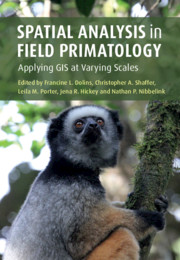12 results
Contributors
-
- Book:
- Spatial Analysis in Field Primatology
- Published online:
- 29 January 2021
- Print publication:
- 18 February 2021, pp x-xiii
-
- Chapter
- Export citation
Plate Section (PDF Only)
-
- Book:
- Spatial Analysis in Field Primatology
- Published online:
- 29 January 2021
- Print publication:
- 18 February 2021, pp 447-470
-
- Chapter
- Export citation
Copyright page
-
- Book:
- Spatial Analysis in Field Primatology
- Published online:
- 29 January 2021
- Print publication:
- 18 February 2021, pp iv-iv
-
- Chapter
- Export citation
Acknowledgments
-
- Book:
- Spatial Analysis in Field Primatology
- Published online:
- 29 January 2021
- Print publication:
- 18 February 2021, pp xiv-xiv
-
- Chapter
- Export citation
16 - Does Reduced Habitat Quality or Increased Hunter Access Explain Defaunation of Fragmented Forests?
- from Part III - GIS Analysis in Broad-Scale Space
-
-
- Book:
- Spatial Analysis in Field Primatology
- Published online:
- 29 January 2021
- Print publication:
- 18 February 2021, pp 349-364
-
- Chapter
- Export citation
Dedication
-
- Book:
- Spatial Analysis in Field Primatology
- Published online:
- 29 January 2021
- Print publication:
- 18 February 2021, pp v-vi
-
- Chapter
- Export citation
Index
-
- Book:
- Spatial Analysis in Field Primatology
- Published online:
- 29 January 2021
- Print publication:
- 18 February 2021, pp 434-446
-
- Chapter
- Export citation
Part III - GIS Analysis in Broad-Scale Space
-
- Book:
- Spatial Analysis in Field Primatology
- Published online:
- 29 January 2021
- Print publication:
- 18 February 2021, pp 307-433
-
- Chapter
- Export citation
Contents
-
- Book:
- Spatial Analysis in Field Primatology
- Published online:
- 29 January 2021
- Print publication:
- 18 February 2021, pp vii-ix
-
- Chapter
- Export citation
Part I - GPS for Primatologists
-
- Book:
- Spatial Analysis in Field Primatology
- Published online:
- 29 January 2021
- Print publication:
- 18 February 2021, pp 7-120
-
- Chapter
- Export citation
Part II - GIS Analysis in Fine-Scale Space
-
- Book:
- Spatial Analysis in Field Primatology
- Published online:
- 29 January 2021
- Print publication:
- 18 February 2021, pp 121-306
-
- Chapter
- Export citation

Spatial Analysis in Field Primatology
- Applying GIS at Varying Scales
-
- Published online:
- 29 January 2021
- Print publication:
- 18 February 2021

